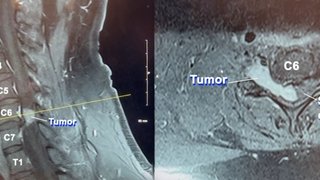Working at home can be a pain in the neck and back
June 5, 2020

Four months into the COVID-19 pandemic, an MIT study found that approximately 34% of former commuters across the U.S. are now WFH – working from home. Add that to the nearly 15% who already worked remotely, and nearly half of U.S. workers might now be telecommuters.
The benefits are many: No more hour-plus commutes. Extra cuddle time with your kids and pets. And less chance a co-worker will "accidentally" eat your lunch.
But as more companies expand and embrace remote working, a major downside has emerged: New or worsening back, neck, leg, and shoulder pain among telecommuters.
The likely culprit? Makeshift home offices.
Many new WFH warriors quickly adapted to a remote working situation during the early days of the COVID-19 crisis. So, many home offices were improvised with whatever was handy:
- A stack of books stands in for a stand-up desk
- An empty coffee container props up your monitor
- That fun, zebra-print chair from your teen's room may look cool, but it probably lacks anything resembling lumbar support
All these workarounds lead to poor ergonomics – fitting a workstation to your body's unique needs. Similar to how poorly fitting shoes punish your feet, that workspace you constructed on the kitchen island can lead to neck and back pain. It’s also too close to the refrigerator if you have joint pain from gaining the "quarantine 15."
Chronic back pain can take a major toll on your life. In the U.S., back pain is a leading cause of missed days at work and school. Without proper care, approximately 20% of people with acute low-back pain will have persistent symptoms within a year.
We have definitely seen a surge in telecommuters scheduling appointments for back pain, either via virtual care appointments or in-person at our UT Southwestern Spine Center offices in Dallas, Frisco, Las Colinas, and Richardson/Plano.
Through secure video chat, you can show our spine experts your workspace and where your body hurts. We can help troubleshoot home office ergonomic fixes and offer simple solutions to reduce or prevent neck and back pain.
1. Take a stand against sitting
Problem area: Neck, shoulders, low-back, and hips.

The average adult sits nine hours per day. Sitting that much is associated with nearly double the risk of type 2 diabetes and a 10% to 20% increased risk of heart disease.
Research has shown that adding bouts of standing at work is great for your health. You'll burn a few extra calories and potentially experience 50% less lower-back pain. But poor sit-stand ergonomics, such as leaning, slouching, or using a workstation that is too high or too low, can lead to muscle and joint pain.
Solid solutions: Consider swapping your book-and-coffee-can setup for a standing desk. You can get a sturdy, adjustable, lightweight desk that sits on a table or countertop for less than $50. Move the desk up and down until your elbows and wrists are at 90-degree angles when you rest your arms to type or move your computer mouse.
Arrange your monitors so you don't have to look up, down, or more excessively to one side. You may need to use a few books after all to position your laptop higher.
Wear comfortable and supportive shoes. Proper footwear supports your arches, knees, and hips, which can improve your posture and prevent or relieve pain all the way up the spine.
Related reading: Can a standing desk help my back pain?
2. Find a chair that fits
Problem areas: Hips, neck, and low back.

Many patients are surprised when I tell them their bedroom or couch seating arrangement is contributing to their pain. Fluffy furniture is comfy. However, slouching over your laptop or lying down while typing is hard on the body. Especially when your 15-minute Zoom meeting turns into an hour.
And can we talk about the zebra-print chair? It looks cool on video conferences, but it’s not the most ergonomically sound chair for you. (And your teen probably wants it back, any way!).
Solid solutions: Choose a chair that delivers both support and comfort to your lower back and hips. If you sit too far forward, you’re arching your back. Too far back and you’re slouching. Neither are good for your spine.
Sitting properly, you should be balanced on top of your “sit bones,” which are the pointy bones under your gluteal muscles. Your core should be tight – imagine drawing your belly button toward your spine – and your lower back, hips, and the backs of your thighs should form an "L."
Consider using a foot stool. Your knees should be at hip level or slightly above to take pressure off the lower back. Avoid crossing your knees or ankles, which also can contribute to low-back pain.
Related reading: 6 ways to improve wellness during the pandemic
3. See the light and the outlets
Problem areas: Neck and shoulders – plus headaches, trip hazards.

If the lighting is poor in your workspace, you'll end up craning your neck and straining your eyes. And when your laptop battery dips to one bar on an important video call, you’ll raise eyebrows when you have to sprawl out to plug in to a distant outlet.
Solid solutions: Position a table-top or floor lamp nearby if you have room and keep it turned on. If space is limited, consider a clip-on light you can affix to your monitor, laptop, or another nearby surface. Try to find a spot where you can sit or stand properly with easy access to an outlet. Use a single, safe, and sturdy extension cord if needed.
Just like at work, you might consider tucking cords under a heavy mat or securing them to the floor with electrical tape – you'll reduce the risk of falling injuries and save face during Zoom calls.
Get moving to prevent and relieve WFH pain
Humans naturally crave routine, and COVID-19 upended our routines on nearly every level. With gyms closed for a long time during the pandemic, many people have adopted a more sedentary lifestyle.
Moving less can lead to weight gain and muscle loss. At the same time, it causes or worsens existing muscle and joint pain. For most patients, exercise should be the first-line treatment for existing low-back pain. If you're still feeling limber, simple exercises and stretches can help prevent neck, back, and joint pain.
Start walking. Set an alarm on your phone or watch as a reminder to get up, move, and stretch every hour when you’re working. A quick walk around the block and a few stretches get the blood flowing, loosen the body, and refresh the mind.
Stretch your hamstrings. Limber up these tendons that run up the back of the thigh to improve poor posture. See 7 easy hamstring stretches.
"Set an alarm on your phone or watch as a reminder to get up, move, and stretch every hour when you’re working. A quick walk around the block and a few stretches get the blood flowing, loosen the body, and refresh the mind."
Kavita Trivedi, D.O.
Rotate your neck. Loosen stiff muscles and improve your range of motion. Slowly nod your head down until you feel a gentle stretch at the base of the neck, then up to look at the ceiling. Next, turn your head side to side in a slow-motion "no" gesture. Just don’t do this on a Zoom call with the boss. Finish with a few gentle, circular rotations, as if you're drawing a circle with your chin. Repeat this cycle a few times each hour.
Squeeze your shoulders. Press your shoulder blades toward the middle of your back. I tell patients to pretend they're putting their elbows in their back pockets. Hold the motion for a few seconds. Do this a couple times each hour to relieve tension and loosen the muscles.
Strengthen your core. Core strength supports good breathing and good posture. Try these easy breathing exercises our Physical Medicine & Rehabilitation team designed for patients recovering from coronavirus. And check out these at-home moves to improve core strength.
Extend your spine. Stand up and lean back, forming an arch with your back for 15 or 20 seconds. Yoga is a great option, too. Try prone press ups, which are similar to the cobra pose in yoga and can significantly relieve low-back pain. This is a floor exercise – more people are willing to get on the floor at home than in the office. Perhaps another WFH benefit!
See Our Spine Center, Up Close and Personal
At UT Southwestern's Spine Center, patients will have access to specialists from an array of disciplines – orthopedics, neurology, and physical medicine and rehabilitation, among others. Working closely together, our spine team will always have your back.
Get timely spine care – even during the pandemic
The UT Southwestern Spine Center and Physical Medicine & Rehabilitation offices are seeing patients in our Dallas and Frisco offices, as well as via telehealth.
For new and existing patients, virtual care appointments are great for acute pain consultations and preventive care, such as guided stretching or ergonomics troubleshooting in your home office. But for more severe or chronic pain, an office visit is better so we can examine your pain points and take images, if needed.
In some instances, back pain might be a medical emergency. If you experience any of these symptoms, go to the emergency room immediately:
- New weakness or tingling in arms and legs
- Numbness in the pelvic area (saddle anesthesia)
- Pain that consistently wakes you up at night
- Severe pain (10 out of 10 on the pain scale)
- Systemic symptoms associated with pain, such as fever, weight loss, or nausea
- Urinary or fecal incontinence
In-person appointments and emergency department care at UT Southwestern are as safe as ever, and we are committed to making you feel as comfortable and confident when you visit any of our medical facilities.
If you are working from home during the pandemic, there are definitely some advantages – it’s likely added valuable time to your day that isn’t spent in traffic or on public transportation.
But don’t let telecommuting add back pain to your job description. Take the time to update your home office, workstation, and daily routine. Your body will thank you.
To visit with a back pain expert, call 214-645-8300 or request an appointment online.











